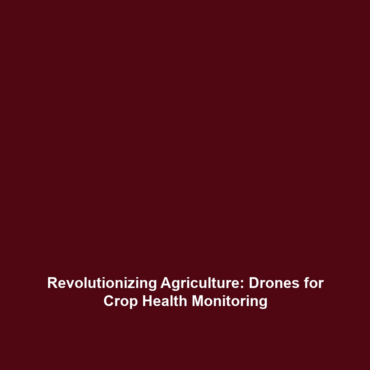Drones in Science: Monitoring Crop Health, Soil Conditions, and Irrigation Patterns
Introduction
Drones have emerged as a transformative technology within the realm of agriculture, significantly enhancing how farmers monitor crop health, soil conditions, and irrigation patterns. This innovation plays a critical role in precision agriculture, allowing for real-time data collection and analysis, ultimately leading to increased crop yields and sustainable farming practices. By utilizing drones equipped with advanced sensors and imaging technology, agronomists can efficiently assess various agricultural parameters, ensuring optimal farming strategies.
Key Concepts
Understanding Drones in Agriculture
In recent years, the application of drones in science, particularly in agriculture, has gained momentum. Key concepts include:
- Remote Sensing: Drones utilize sensors to collect data from the ground without physical contact.
- Data Analysis: Advanced algorithms analyze data for actionable insights on crop health and soil conditions.
- Multispectral Imaging: This technology allows farmers to capture images beyond the visible spectrum, revealing vital information about plant health.
These principles are integral to the functionality of drones in monitoring crop health, soil conditions, and irrigation patterns, thereby exemplifying their contribution to the field of Drones in Science.
Applications and Real-World Uses
The application of drones to monitor crop health, soil conditions, and irrigation patterns is revolutionizing agriculture. Some of the most significant real-world uses include:
- Crop Health Monitoring: Drones can quickly identify areas of a field that require attention by analyzing plant health indicators.
- Soil Condition Assessment: By mapping the soil moisture levels and composition, drones help farmers optimize irrigation schedules.
- Irrigation Management: Drones provide crucial information that guides effective water usage, minimizing waste.
These examples highlight how drones are being increasingly integrated into agricultural practices within the category of Drones in Science.
Current Challenges
Despite their potential, the implementation of drones to monitor crop health, soil conditions, and irrigation patterns faces several challenges:
- Regulatory Hurdles: Legal and regulatory restrictions limit drone operations in many regions.
- High Initial Costs: The investment required for drone technology can be a barrier for small-scale farmers.
- Data Overload: The vast amount of data collected can be overwhelming, necessitating advanced data management solutions.
Addressing these challenges is crucial to maximizing the effectiveness of drones within the broader context of Drones in Science.
Future Research and Innovations
Looking ahead, substantial innovations are anticipated in the field of drones used for agricultural monitoring. Key areas of future research include:
- Artificial Intelligence Integration: Enhancing data analysis through AI can lead to more precise recommendations for crop management.
- Improved Sensor Technology: Next-generation sensors will provide even more detailed insights into crop and soil conditions.
- Sustainable Practices: Research focusing on minimizing environmental impact will become increasingly important.
These innovations promise to revolutionize the field, showcasing the future potential of Drones in Science.
Conclusion
In summary, the utilization of drones to monitor crop health, soil conditions, and irrigation patterns represents a pivotal advancement within the context of Drones in Science. With the ability to provide real-time insights and facilitate sustainable agricultural practices, drones are reshaping the landscape of modern farming. For further reading on the intersection of technology and agriculture, explore our content on Precision Agriculture and Innovations in Agriculture.
